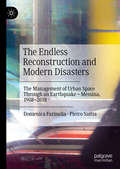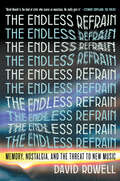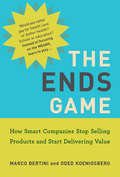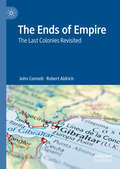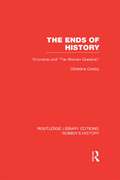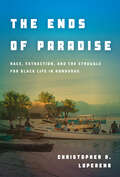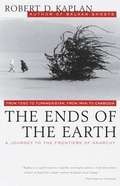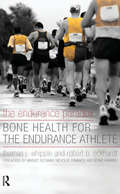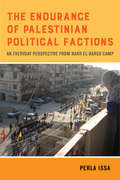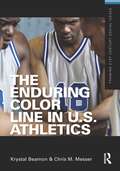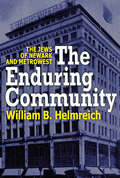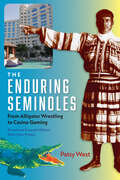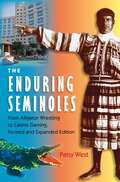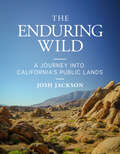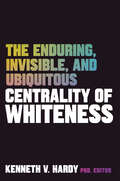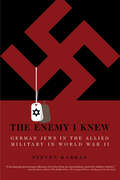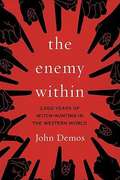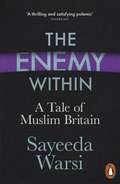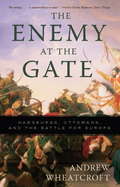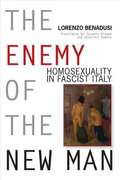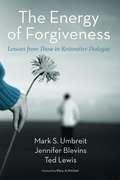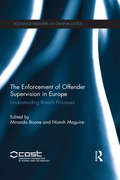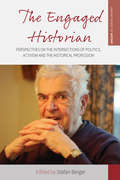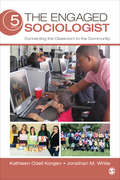- Table View
- List View
The Endless Reconstruction and Modern Disasters: The Management of Urban Space Through an Earthquake – Messina, 1908–2018 (Disaster Studies)
by Domenica Farinella Pietro SaittaThis is a study on the long-lasting consequences of a disastrous earthquake that hit the city of Messina, Sicily, in 1908. The quake killed about 86,000 people, and destroyed one of the most important portal cities of the Mediterranean. The book investigates both the forces that shaped that event and made it possible – firstly, urban speculation processes at the end of the nineteenth century – and the role of that occurrence in creating a complex event that, on the one hand, accelerated trends and tendencies that were already in motion; and, on the other, produced an entirely new social space based on social separation and the raise of a widespread marginal class. Such a class developed within urban borders and spaces that, over the decades, grew according to the same logic and directions that followed the reconstruction. Especially the shacks, still a visible presence in the city, represent the lieu of reproduction both of a class and the whole of the social relations stemming from the disaster.It shows how key-concepts in contemporary scientific analysis, such as “shock economy” and “economy of disaster,” can be aptly backdated. Above all, this study broadens the normal analyses of disasters by showing the stratification of institutional techniques and economic forces that, over the decades, intervened and (re-)shaped the site of a disaster and its social structure.
The Endless Refrain: Memory, Nostalgia, and the Threat to New Music
by David RowellA veteran music journalist argues that the rise of music streaming and the consolidation of digital platforms is decimating the musical landscape, with dire consequences for the future of our culture …In The Endless Refrain, former Washington Post writer and editor David Rowell lays out how commercial and cultural forces have laid waste to the cultural ecosystems that have produced decades of great American music. From the scorched-earth demonetizing of artist revenue accomplished by Spotify and its ilk to the rise of dead artists &“touring&” via hologram, Rowell examines how a perfect storm of conditions have drained our shared musical landscape of vitality.Combining personal memoir, intimate on-the-ground reporting, industry research, and cultural criticism, Rowell&’s book is a powerful indictment of a music culture gone awry, driven by conformity and subverted by the ways the internet and media influence what we listen to and how we listen to it.
The Ends Game: How Smart Companies Stop Selling Products and Start Delivering Value (Management on the Cutting Edge)
by Marco Bertini Oded KoenigsbergRewrites the rules of commerce by pursuing outcomes rather than products; the seventh book in the Management on the Cutting Edge series comes from a definitive source--the MIT Sloan Management Review.Would you rather pay for healthcare or for better health? For school or education? For groceries or nutrition? A car or transportation? A theater performance or entertainment? In The Ends Game, Marco Bertini and Oded Koenigsberg describe how some firms are rewriting the rules of commerce: instead of selling the "means" (their products and services), they adopt innovative revenue models to pursue "ends" (actual outcomes). They show that paying by the pill, semester, food item, vehicle, or show does not necessarily reflect the value that customers actually derive from their purchases. Revenue models anchored on the ownership of products, they argue, are patently inferior.
The Ends of Empire: The Last Colonies Revisited
by Robert Aldrich John ConnellThis book offers a fresh analysis of constitutional, economic, demographic and cultural developments in the overseas territories of Britain, France, the Netherlands, Denmark, Spain, the United States, Australia and New Zealand. Ranging from Greenland to Gibraltar, the Falklands to the Faroes, and encompassing islands in the Atlantic, Pacific and Indian Oceans, and the Caribbean, these territories command attention because of their unique status, and for the ways that they occasionally become flashpoints for rival international claims, dubious financial activities, illegal migration and clashes between metropolitan and local mores. Connell and Aldrich argue that a negotiated dependency brings greater benefits to these territories than might independence.
The Ends of History: Victorians and "the Woman Question" (Routledge Library Editions: Women's History)
by Christina CrosbyWhy were the Victorians so passionate about "History"? How did this passion relate to another Victorian obsession – the "woman question"? In a brilliant and provocative study, Christina Crosby investigates the links between the Victorians’ fascination with "history" and with the nature of "women." Discussing both key novels and non-literary texts – Daniel Deronda and Hegel’s Philosophy of History; Henry Esmond and Macaulay’s History of England; Little Dorrit, Wilkie Collins’ The Frozen Deep, and Mayhew’s survey of "labour and the poor"; Villette, Patrick Fairburn’s The Typology of Scripture and Ruskin’s Modern Painters – she argues that the construction of middle-class Victorian "man" as the universal subject of history entailed the identification of "women" as those who are before, beyond, above, or below history. Crosby’s analysis raises a crucial question for today’s feminists – how can one read historically without replicating the problem of nineteenth century "history"? The book was first published in 1991.
The Ends of Paradise: Race, Extraction, and the Struggle for Black Life in Honduras
by Christopher LoperenaThe future of Honduras begins and ends on the white sand beaches of Tela Bay on the country's northeastern coast where Garifuna, a Black Indigenous people, have resided for over two hundred years. In The Ends of Paradise, Christopher Loperena examines the Garifuna struggle for life and collective autonomy, and demonstrates how this struggle challenges concerted efforts by the state and multilateral institutions, such as the World Bank, to render both their lands and their culture into fungible tourism products. Using a combination of participant observation, courtroom ethnography, and archival research, Loperena reveals how purportedly inclusive tourism projects form part of a larger neoliberal, extractivist development regime, which remakes Black and Indigenous territories into frontiers of progress for the mestizo majority. The book offers a trenchant analysis of the ways Black dispossession and displacement are carried forth through the conferral of individual rights and freedoms, a prerequisite for resource exploitation under contemporary capitalism. By demanding to be accounted for on their terms, Garifuna anchor Blackness to Central America—a place where Black peoples are presumed to be nonnative inhabitants—and to collective land rights. Steeped in Loperena's long-term activist engagement with Garifuna land defenders, this book is a testament to their struggle and to the promise of "another world" in which Black and Indigenous peoples thrive.
The Ends of the Earth: A Journey at the Dawn of the 21st Century
by Robert D. Kaplan<P>Author of Balkan Ghosts, Robert D. Kaplan now travels from West Africa to Southeast Asia to report on a world of disintegrating nation-states, warring nationalities, metastasizing populations, and dwindling resources. He emerges with a gritty tour de force of travel writing and political journalism. Whether he is walking through a shantytown in the Ivory Coast or a death camp in Cambodia, talking with refugees, border guards, or Iranian revolutionaries, Kaplan travels under the most arduous conditions and purveys the most startling truths. Intimate and intrepid, erudite and visceral, The Ends of the Earth is an unflinching look at the places and peoples that will make tomorrow's headlines--and the history of the next millennium. <P>"Kaplan is an American master of...travel writing from hell...Pertinent and compelling."--New York Times Book Review "An impressive work. Most travel books seem trivial beside it."--Washington Post Book World
The Endurance Paradox: Bone Health for the Endurance Athlete
by Thomas J Whipple Robert B EckhardtThe endurance athlete faces a paradox—you’re going farther and faster, you’re feeling stronger, but your bones are getting weaker. New, compelling evidence shows that the very activities that expand our mental and physical abilities may be reducing the durability of our skeletons. In this book, Thomas Whipple, a leading orthopaedic clinical specialist, and Robert Eckhardt, a scientist specializing in the musculoskeletal system, team up to explain how athletes at any level can maintain the delicate balance between endurance exercise and optimum bone health over a lifetime. Translating important scientific advances into accessible language, they explain the muscle-bone connection, and cover training strategies and exercises, nutrition, calcium, stress fractures, rehabilitation, running mechanics, footwear, posture, and pharmaceuticals. An essential guide and ideal text for exercise physiologists, endurance athletes, fitness enthusiasts, and coaches.
The Endurance of Palestinian Political Factions: An Everyday Perspective from Nahr el-Bared Camp (New Directions in Palestinian Studies #3)
by Perla IssaA free open access ebook is available upon publication. Learn more at www.luminosoa.org.The Endurance of Palestinian Political Factions is an ethnographic study of Palestinian political factions in Lebanon through an immersion in daily home life. Perla Issa asks how political factions remain the center of political life in the Palestinian camps in the face of mounting criticism. Through an examination of the daily, mundane practices of refugees in Nahr el-Bared camp in particular, this book shows how intimate, interpersonal, and kin-based relations are transformed into political networks and offers a fresh analysis of how those networks are in turn metamorphosed into political structures. By providing a detailed and intimate account of this process, this book reveals how factions are produced and reproduced in everyday life despite widespread condemnation.
The Enduring Color Line in U.S. Athletics (Framing 21st Century Social Issues)
by Krystal Beamon Chris M. MesserSports are an integral part of American society. Millions of dollars are spent every year on professional, collegiate, and youth athletics, and participation in and viewing of these sports both alter and reflect how one perceives the world. Beamon and Messer deftly explore sports as a social construction, and more significantly, the large role race and ethnicity play in sports and consequently sports’ influence on modern race relations. This text is ideal for courses on Sport and Society as well as Race and Ethnicity.
The Enduring Community: The Jews of Newark and MetroWest
by William B. HelmreichFrom its founding in the late seventeenth century, Newark, New Jersey, was a vibrant and representative center of Jewish life in America. Geographically and culturally situated between New York City and its outlying suburbs, Newark afforded Jewish residents the advantages of a close-knit community along with the cultural abundance and social dynamism of urban life. In Newark, all of the representative stages of modern Jewish experience were enacted, from immigration and acculturation to upward mobility and community building. The Enduring Community is a lively and evocative social history of the Jewish presence in Newark as well as an examination of what Newark tells us about social assimilation, conflict and change.Grounded in documentary research, the volume makes extensive use of interviews and oral histories. The author traces the growth of the Jewish population in the pre-Revolutionary period to its settlement of German Jews in the 1840s and Eastern European Jews in the 1880s. Helmreich delineates areas of contention and cooperation between these groups and relates how an American identity was eventually forged within the larger ethnic mix of the city. Jewish population in politics, the establishment of Jewish schools, synagogues, labor unions, charities, and community groups are described together with cultural and recreational life. Despite the formal and emotional bonds that formed over a century, Jewish neighborhoods in Newark did not survive the postwar era. The trek to the suburbs, the erosion of Newark's tax base, and deteriorating services accelerated a movement outward that mirrored the demographic patterns of cities across America. By the time of the Newark riots in 1967, the Jewish presence was largely absent.This volume reclaims a lost history and gives personalized voice to the dreams, aspirations, and memories of a dispersed community. It demonstrates how former Newarkers built new Jewish communities in the surrounding suburbs, an area dubbed "MetroWest" by Jewish leaders. The Enduring Community is must reading for students of Jewish social history, sociologists, urban studies specialists, and readers interested in the history of New Jersey. The book includes archival photographs form the periods discussed.
The Enduring Seminoles: From Alligator Wrestling to Casino Gaming (Florida History and Culture)
by Patsy WestFlorida Historical Society Harry T. and Harriette V. Moore AwardA history of the cultural tourism activities of the Florida Seminoles In the early twentieth century, the Florida Seminoles struggled to survive in an environment altered by the drainage of the Everglades and a dwindling demand for animal hides. This revised and expanded edition of The Enduring Seminoles, now updated with a new preface, discusses the cultural tourism activities of the Seminoles over the decades that followed. By the 1930s almost all of the Florida Seminole population was engaged in the tourist market. They participated in fairs and expositions in Chicago, New York, and Canada. In large commercial Seminole villages in Miami and Ocala, they sewed brightly colored patchwork, wrestled alligators, and opened their palm-frond chickees to the public. Their exhibition economy provided income for families, and today, the Seminole Tribe of Florida and the Miccosukee Tribe of Indians of Florida promote their tourist activities to worldwide markets. Drawing on interviews with many Seminoles and extending to the Seminole Tribe’s purchase of the Hard Rock Café business in 2007, The Enduring Seminoles provides a colorful social and economic history of an unconquered people. A volume in the Florida History and Culture series, edited by Raymond Arsenault and Gary R. Mormino
The Enduring Semioles: From Alligator Wrestling to Casino Gaming (Florida History and Culture)
by Patsy WestEarly in this century, the Florida Seminoles struggled to survive in an environment altered by the drainage of the Everglades and a dwindling demand for animal hides. This revised and expanded edition is the only book available on the cultural tourism activities of an Indian tribe.Often told in the words of the many Seminoles interviewed for this book, this is a tale of unbelievable success against all odds as the Seminoles went from abject poverty to striking the first major international deal by a tribe with the purchase of the Hard Rock Café in 2006.
The Enduring Wild: A Journey into California's Public Lands
by Josh JacksonA galvanizing road trip across California's immense public wilderness from a beloved adventurer."The Enduring Wild is a call to look beyond the surface, embrace the deep connections that tie us to our public lands, and commit to safeguarding them for future generations." —QT Luong, author of Treasured Lands: A Photographic Odyssey Through America's National ParksIt all began with a camping trip. Outdoor enthusiast Josh Jackson had never heard of "BLM land" before a casual recommendation from a friend led him to a free campsite in the desert—and the revelation that over 15 million acres of land in California are owned collectively by the people. In The Enduring Wild, he takes us on a road trip spanning thousands of miles, crisscrossing the Golden State to seek out every parcel of public wilderness therein belonging to the federal Bureau of Land Management, from the Pacific shores of the King Range down to the Mojave Desert. Over mountains, across prairies, and through sagebrush, Jackson unravels the stories of these lands. He tells of the Indigenous peoples who have called them home for millennia, of the extractivist threats that imperil them today, and of the grassroots organizers and political champions who have rallied to their common defense to uphold the radical mandate to protect these natural treasures for generations to come. For the adventurers, campers, explorers, map readers, road trippers, nature enthusiasts, and public lands lovers out there, The Enduring Wild is an indispensable invitation to know these places more deeply and to embrace our common inheritance. Illustrations by Rebekah Nolan.
The Enduring, Invisible, and Ubiquitous Centrality of Whiteness
by Kenneth V. HardyA comprehensive collection on the topic of whiteness from writers in the field of mental health and activism. Whiteness is a pervasive ideology that is rarely overtly identified or examined, despite its profound effects on race relationships. Being intentional about naming, deconstructing, and dismantling whiteness is a precursor to responding effectively to the racial reckoning of our society and improving race relationships, addressing systemic bias, and moving towards the creation of a more racially just world. In this collection of essays, scholars from a variety of backgrounds and trainings explore how the longstanding centering of whiteness in all aspects of society, including clinical therapy spaces, has led to widespread racial injustice. Contributors include: David Trimble, Lane Arye, Jodie Kliman, Ken Epstein, Toby Bobes, Cynthia Chestnut, Ovita F. Williams, Gene E. Cash Jr., Carlin Quinn, Christiana Ibilola Awosan, Niki Berkowitz, Jen Leland, Mary Pender Greene, Hinda Winawer, Bonnie Berman Cushing, Michael Boucher, Robin Schlenger, Alana Tappin, Timothy Baima, Liang-Ying Chou, Irene In Hee Sung, Ana Hernandez, Robin Nuzum, Keith A. Alford, Hugo Kamya, and Cristina Combs.
The Enemy I Knew: German Jews in the Allied Military in World War II
by Steven KarrasJewish refugees who fled the Nazis—then returned to fight them as Allied soldiers—share their experiences: “Heroic, poignant [and] compelling.” —The Daily NewsEven Holocaust survivor Elie Wiesel struggled with the question: Why didn’t the Jews fight back? But he finally concluded that the real question was how so many of them did. As he put it, “Tormented, beaten, starved, where did they find the strength—spiritual and physical—to resist?” In fact, over 10,000 German Jews fought in the Allied armies of World War II. This book honors those European-born combat veterans—refugees from the Nazi regime in Germany and Austria who faced their persecutors by joining the Allied forces in a fight against the country of their birth. These twenty-seven interviews take us into the unique and harrowing experiences of brave men—and one brave woman—whose service restored a sense of dignity and allowed them to rise above their former victimization. All burned with anger at the Germans who’d subjected them, often as young children, to cruelty in everyday life in their hometowns, and to ridicule in the national media. As soldiers who knew the language and psychology of the enemy better than any of their comrades, they struck back with newfound pride against the rampant injustice that had annihilated their families, destroyed their prospects, and subjected many of them to the worst forms of physical abuse, both random and terrifying. In The Enemy I Knew they tell their stories—and the world is richer for their heroic acts, and for their testimony.“It is rare to come across a book about a forgotten story from World War II, but Steve Karras has found one of the most compelling, little-known accounts from the war and he tells it brilliantly. Harrowing, breathtaking in parts, and completely absorbing.” —Andrew Carroll, New York Times–bestselling editor of War Letters“Few stories can rival the ones told in The Enemy I Knew.” —Library Journal (starred review)
The Enemy Within
by John DemosWith the vision of a historian and the voice of a novelist, prize?winning author John Demos explores the social, cultural, and psychological roots of the scourge that is witch-hunting, both in the remote past and today. The Enemy Within chronicles the most prominent witch-hunts of the Western world?women and men who were targeted by suspicious neighbors and accused of committing horrific crimes by supernatural means?and shows how the fear of witchcraft has fueled recurrent cycles of accusation, persecution, and purging. A unique and fascinating book, it illumines the dark side of communities driven to rid themselves of perceived evil, no matter what the human cost. .
The Enemy Within: A Tale of Muslim Britain
by Sayeeda Warsi'Hard headed, well informed and intellectually coherent ... it turns conventional wisdom on its head. It deserves to promote a public debate on this subject which has been needed for more than 20 years' Peter OborneBritain has often found groups within its borders whom it does not trust, whom it feels have a belief, culture, practice or agenda which runs contrary to those of the majority. From Catholics to Jews, miners to trade unionists , Marxists to liberals and even homosexuals, all have at times been viewed, described and treated as 'the enemy within'. Muslims are the latest in a long line of 'others' to be given this label. How did this state of affairs come to pass? What are the lessons and challenges for the future - and how will the tale of Muslim Britain develop? Sayeeda Warsi draws on her own unique position in British life, as the child of Pakistani immigrants, an outsider, who became an insider, the UK's first Muslim Cabinet minister, to explore questions of cultural difference, terrorism, surveillance, social justice, religious freedom, integration and the meaning of 'British values'.Uncompromising and outspoken, filled with arguments, real-life experience, necessary truths and possible ways forward for Muslims, politicians and the rest of us, this is a timely and urgent book.'This thoughtful and passionate book offers hope amid the gloom' David Anderson QC, Independent Reviewer of Terrorism Legislation'A vital book at a critical time' Helena Kennedy QC
The Enemy at the Gate: Habsburgs, Ottomans, and the Battle for Europe
by Andrew WheatcroftIn 1683, an Ottoman army that stretched from horizon to horizon set out to seize the "Golden Apple,” as Turks referred to Vienna. The ensuing siege pitted battle-hardened Janissaries wielding seventeenth-century grenades against Habsburg armies, widely feared for their savagery. The walls of Vienna bristled with guns as the besieging Ottoman host launched bombs, fired cannons, and showered the populace with arrows during the battle for Christianity’s bulwark. Each side was sustained by the hatred of its age-old enemy, certain that victory would be won by the grace of God. The Great Siege of Vienna is the centerpiece for historian Andrew Wheatcroft’s richly drawn portrait of the centuries-long rivalry between the Ottoman and Habsburg empires for control of the European continent. A gripping work by a master historian, The Enemy at the Gate offers a timely examination of an epic clash of civilizations.
The Enemy of the New Man
by Lorenzo BenadusiIn this first in-depth historical study of homosexuality in Fascist Italy, Lorenzo Benadusi brings to light immensely important archival documents regarding the sexual politics of the Italian Fascist regime; he adds new insights to the study of the complex relationships of masculinity, sexuality, and Fascism; he explores the connections between new Fascist values and preexisting Italian traditional and Roman Catholic views on morality; he documents both the Fascist regime’s denial of the existence of homosexuality in Italy and its clandestine strategies and motivations for repressing and imprisoning homosexuals; he uncovers the ways that accusations of homosexuality (whether true or false) were used against political and personal enemies; and above all, he shows how homosexuality was deemed the enemy of the Fascist “New Man,” an ideal of a virile warrior and dominating husband vigorously devoted to the “political” function of producing children for the Fascist state. Benadusi investigates the regulation and regimentation of gender in Fascist Italy, and the extent to which, in uneasy concert with the Catholic Church, the regime engaged in the cultural and legal engineering of masculinity and femininity. He cites a wealth of unpublished documents, official speeches, letters, coerced confessions, private letters and diaries, legal documents, and government memos to reveal and analyze how the orders issued by the regime attempted to protect the “integrity of the Italian race. ” For the first time, documents from the Vatican archives illuminate how the Catholic Church dealt with issues related to homosexuality during the Fascist period in Italy.
The Energy of Forgiveness: Lessons From Those In Restorative Dialogue
by Mark UmbreitForgiveness is a life-changing experience for many people who have been hurt by others. But forgiveness is paradoxical in that if one relies on forgiveness language or if others prescribe it as an expectation, the depth of that experience can be significantly compromised. Many people experience deep forgiveness without ever using the language of forgiveness.New research on the benefits of forgiveness is on the rise these days, yet there is often little narrative to show the power of forgiveness.
The Enforcement of Offender Supervision in Europe: Understanding Breach Processes (Routledge Frontiers of Criminal Justice)
by Miranda Boone Niamh MaguireThis book provides a comparative analysis of the process of breach across ten different European jurisdictions by identifying and elaborating a number of key analytical themes through which the different systems can be compared and evaluated. It is informed by and hopes to advance the research activities of the COST Action IS1106 on Offender Supervision in Europe, particularly the Action’s work on developing new comparative methodologies to examine the process of decision-making involved in the breaching of offenders for non-compliance. This volume consists of country chapters and thematic chapters. Analyses are based on exhaustive reviews of the literature available in each jurisdiction as well as the results of an empirical pilot study to provide a unique and valuable insight into current practice as well as enhancing our understanding of the contingencies and vagaries of the processes of breach as they exist in both civil and common law European jurisdictions. The key themes and emerging concerns that are explored include: the roles and responsibilities of the different actors involved in the breach process; the degree and nature of discretion exercised by decision-makers; and legitimacy, due process and procedural requirements of breach processes both from a pan-European and from a comparative perspective. This book will be of interest to criminal lawyers and criminologists, policy makers, criminal justice practitioners, probation workers and students of criminal justice studies across Europe. Comparative insight into the decision-making processes of breach across Europe will also be of interest to American, Canadian and Australian audiences seeking comparisons with their own systems.
The Engaged Historian: Perspectives on the Intersections of Politics, Activism and the Historical Profession (Making Sense of History #37)
by Stefan BergerOn the surface, historical scholarship might seem thoroughly incompatible with political engagement: the ideal historian, many imagine, is a disinterested observer focused exclusively on the past. In truth, however, political action and historical research have been deeply intertwined for as long as the historical profession has existed. In this insightful collection, practicing historians analyze, reflect on, and share their experiences of this complex relationship. From the influence of historical scholarship on world political leaders to the present-day participation of researchers in post-conflict societies and the Occupy movement, these studies afford distinctive, humane, and stimulating views on historical practice and practitioners
The Engaged Historian: Perspectives on the Intersections of Politics, Activism and the Historical Profession (Making Sense of History #37)
by Stefan BergerOn the surface, historical scholarship might seem thoroughly incompatible with political engagement: the ideal historian, many imagine, is a disinterested observer focused exclusively on the past. In truth, however, political action and historical research have been deeply intertwined for as long as the historical profession has existed. In this insightful collection, practicing historians analyze, reflect on, and share their experiences of this complex relationship. From the influence of historical scholarship on world political leaders to the present-day participation of researchers in post-conflict societies and the Occupy movement, these studies afford distinctive, humane, and stimulating views on historical practice and practitioners
The Engaged Sociologist: Connecting the Classroom to the Community
by Kathleen Odell Korgen Jonathan M. WhiteThis fully updated edition of The Engaged Sociologist by Kathleen Odell Korgen carries the public sociology movement into the classroom, while at the same time providing an engaging overview of the entire field. It demonstrates how to think sociologically, to develop a sociological eye, and to use sociological tools to become effective participants in a democratic society. Perfect as a supplement for an introductory course, or as a main text for any course that has public sociology at its roots, this inspiring book will serve as a guidebook to any student who is passionate about applying sociological concepts to the world around them.
